Vietnam, with its diverse landscapes and rich cultural heritage, welcomes travelers year-round. But the question remains: "When is the best time to visit Vietnam?". Whether your travel dates are fixed or flexible, this guide will help you navigate Vietnam's diverse regions and varied seasons. Choosing the right time can greatly enhance your travel experience. Izitour will guide you through climate, the travel seasons, and festivals across the country, helping you determine the ideal time to visit Vietnam.
1. General climate characteristics of Vietnam
Vietnam's unique geography, stretching across 16 latitudes, creates a fascinating array of weather patterns. Furthermore, the country has a tropical monsoon climate, divided into the southwest or south monsoon occurring from May to October (summer monsoon) and the prevailing northeast monsoon from November to April (winter monsoon). This means deciding the good time to visit Vietnam depends on which part of Vietnam you will visit. As you plan your adventure, understanding these regional variations will help you make the most of your trip.

Northern Vietnam's Climate
Northern Vietnam, home to Hanoi, Halong Bay, Ninh Binh, Sapa, Ha Giang and the other stunning mountainous regions, offers a classic four-season experience. If you spend your whole time in the North of Vietnam, October to April offers the most pleasant weather for exploring. Spring (February-May) is a delightful time with mild temperatures and occasional light rain. Summer (June-August) is hot and humid with frequent, sometimes heavy rain showers. Autumn (September-November) is cool, dry and comfortable, ideal for exploring the outdoors. Winter (December-January) has cooler temperatures and little rain, but the northeast monsoon can bring chilly winds.
Central Vietnam's Climate
Central Vietnam is famous for its majestic Hai Van Pass, which has created two distinct climate zones. The area from Phong Nha-Ke Bang to Hue experiences four seasons, similar to the north. South Central Hoi An, Da Nang, Quy Nhon, Nha Trang are more akin to the south, expect warm, tropical weather year-round. If you are planning to travel to Central Vietnam, it is enjoyable to explore from December to September. Just be cautious for October and November when storms, heavy rain, and flooding can occur.
Southern Vietnam's Climate
Southern Vietnam, including Ho Chi Minh City, the Mekong Delta, and beautiful beaches like Phan Thiet, Phu Quoc and Con Dao, enjoys a consistently hot climate with two main seasons: dry and rainy seasons. The Dry Season (November-April) is perfect for outdoor activities, beach trips, and island hopping. Rainy Season (May-October) is characterized by short, intense afternoon showers. While it does rain, it often happens late afternoon and doesn't last long, leaving plenty of time for sightseeing. You can visit southern Vietnam any time of year. However, the dry season (November-April) is ideal for those who want to avoid the rain.
2. Best time to visit Vietnam by Month
2.1. Travel to Vietnam in January and February
Winter in Vietnam is unique, offering a different experience than the summer months. With pleasant temperatures, it's many travelers’ favourite time to explore Vietnam from North to South.
Vietnam Weather in January-February
In Northern Vietnam, this period is winter. These are coolest months with low humidity and chilly morning. Temperatureaverage is between 10-20°C, perfect for sightseeing. However, in mountainous areas like Sapa be prepared for some fog.
Central Vietnam enjoys mild weather. Phong Nha and Hue might have drizzles when the cold air massive arrives. The beaches might be chilly for swimming, but the cooler temperatures (20-28°C) are great for exploring historic sites.
Differs from other regions, this is prime time for the south. Temperatures are between 25-29°C. Sunshine abounds, rain is rare, and the beaches are absolutely gorgeous. It's ideal weather for outdoor adventures and relaxing by the sea.
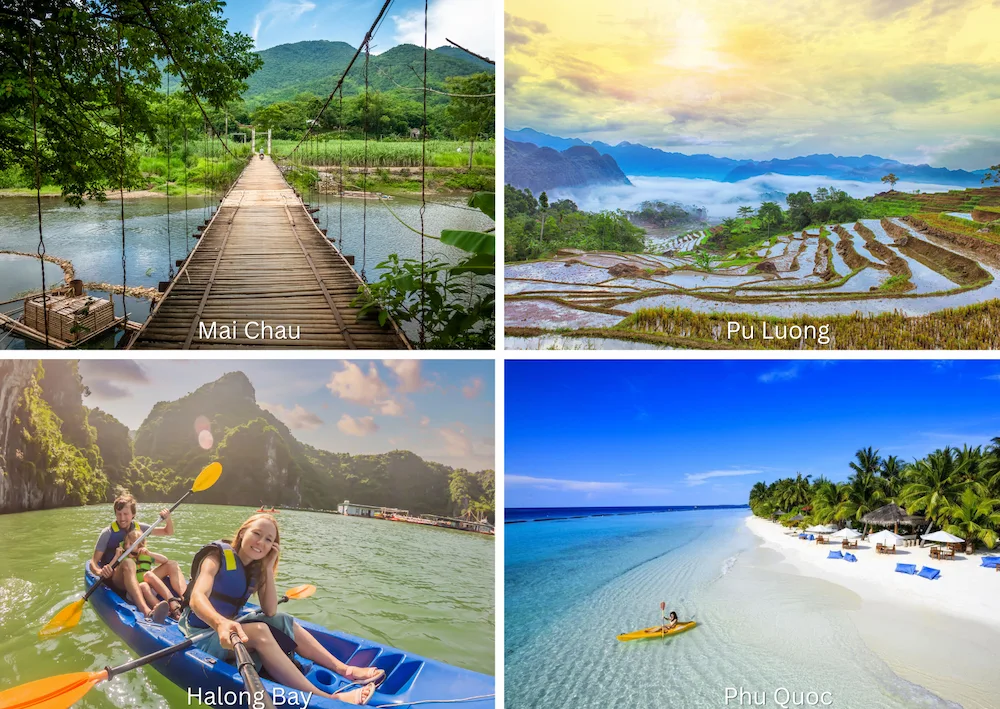
The Best Things to Do in Vietnam in January-February
Undeniably, January and February are perfect for exploring iconic Vietnam route of Hanoi - Halong Bay - Ninh Binh - Hue - Hoi An - Ho Chi Minh - Mekong Delta.
Besides, with cooler temperatures and dry trails, it's an excellent time to trek through the northern mountains. Trekking enthusiasts can consider Mai Chau, Pu Luong, Ha Giang, Cao Bang, where the fog is less prevalent than in Sapa. You should also remember to pack warm layers for chilly evenings.
For those beach seekers, head south for a fantastic beach vacation. Soak up the sun in Nha Trang, Mui Ne, or on the idyllic islands of Con Dao, Phu Quoc. The Southern beaches’ water is clear, the skies are blue, not like the Northern and Central regions. The vibes are pure relaxation.
While it might not be swimming weather, a Halong Bay cruise is still stunning in some moments of winter’s sunny days. The misty landscapes in the morning offer a unique, ethereal beauty.
Tet (Vietnamese Lunar New Year) and Important Notes
Tet, which falls around late January or early February, is Vietnam's biggest and most important holiday. It marks the beginning of the Lunar Year and is a time for family gatherings, traditional rituals, and cultural celebrations. In 2025, Tet will begin on Wednesday, January 29th. Vietnamese people will have a week off from work to celebrate this special occasion.
Before Tet, there's so much excitement as people shop and get ready, filling the streets with vibrant energy. During Tet, the streets quiet down as families come together at home for traditional celebrations. After Tet, people travel, join in spring festivals, and slowly get back to their daily routines. If you do end up visiting during Tet, stay at a homestay for a more authentic experience.
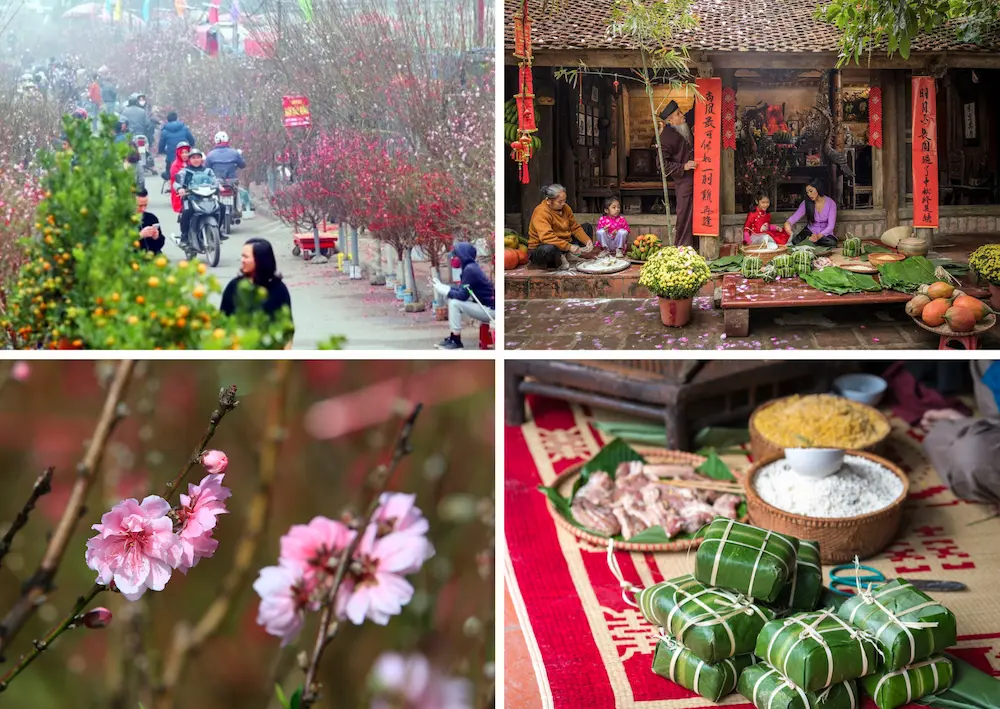
While it's a wonderful time to experience local culture, there is something to note.
During Tet, in Hanoi and the surrounding northern regions, many businesses and services shut down. Most banks, government offices, and many local restaurants and shops, particularly smaller family-run businesses, will be closed for several days. Larger establishments or those catering to tourists may have reduced hours or remain open. Transportation schedules might also be reduced.
However, in central and southern Vietnam, the impact of Tet on businesses is generally less significant. While banks and the Immigration Department are closed, especially during the first few days of Tet, many restaurants and shops will remain open.
Due to the limited availability during Tet, both transportation and accommodation are more expensive than usual, which can add significantly to the travel budget.
Domestic flights see a price surge during Tet, especially for popular routes like Ho Chi Minh to Hanoi if the flight date is before Tet and Hanoi to Ho Chi Minh City if the flight date is after Tet. While train tickets may not experience the same drastic price increases as flights, they still cost more than usual. You are recommended to book flights and train tickets as soon as possible.
Besides, travelers should be mindful of the regional markets' differences to fully experience the vibrant atmosphere of Tet shopping. Though Vietnamese traditional markets are even more bustling when Tet comes very near, they are quiet during Tet. These markets in northern cities like Hanoi usually remain open until New Year's Eve, then they become quiet for a few days. In northern mountainous areas, a long break follows, sometimes even up to half a month. Conversely, floating markets in the Mekong Delta tend to close earlier, typically around the 27th of the last lunar month, and reopen after the 5th of Tet.
After Tet, especially on weekends, avoid popular tourist destinations for Vietnamese pilgrimages such as Perfume Pagoda, Bai Dinh Pagoda, Trang An (Ninh Binh).
If your travel dates are flexible, I'd suggest considering visiting Vietnam before or after Tet rather than during Tet.
>> See the list of Vietnam featured tours with real-time price
2.2. Travel to Vietnam in March and April
March and April are the peak seasons for European tourists visiting Vietnam due to the favorable climate from North to South, and tourists also have longer vacations.
Vietnam Weather in March-April
March and April bring spring to northern Vietnam, offering some of the most pleasant weather. Hanoi, Halong Bay, Ninh Binh, and Sapa are mild and sunny, with temperatures ranging between 17-27°C. The occasional light showers revitalize the landscape and create lush green scenery.
Central Vietnam, encompassing Hue, Da Nang, and Hoi An, also enjoys delightful weather in March and April. While temperatures are warmer than in the north, they remain comfortable, usually in the 21-31°C.
Ho Chi Minh City, the Mekong Delta, Phu Quoc, and other southern provinces continue to bask in the dry season's glory. Days are long and sunny, with temperatures often reaching the 30-35°C.
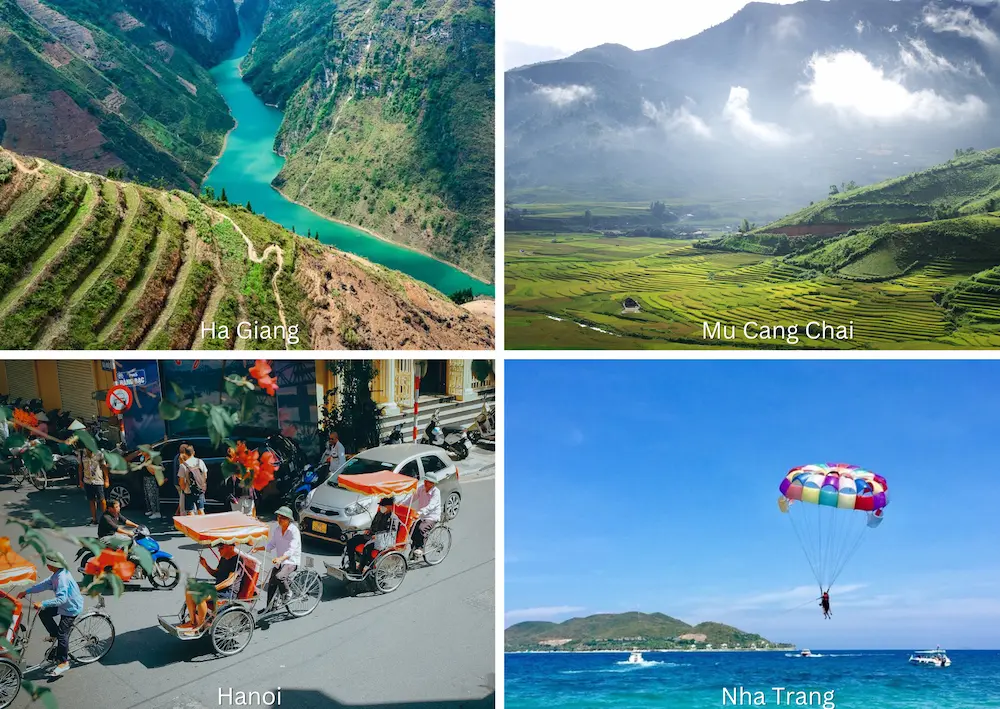
The Best Things to Do in Vietnam in March-April
Vietnam in March and April offers a delightful mix of experiences for travelers. With pleasant weather across the country, it's an ideal time to explore all the popular landmarks of Vietnam, like Hanoi's Old Quarter, Ho Chi Minh City, Da Nang, Hoi An, and many more destinations you can name without the intense heat of summer.
For those seeking adventure, it's a fantastic time for outdoor activities like hiking, cycling, and exploring the region's natural beauty. The north has excellent trekking conditions, particularly in Mai Chau and Pu Luong, where the rice has already been transplanted, turning the fields into lush green. Other scenic trekking spots include the valley in Nghia Lo, Tu Le, Ha Giang, and the northeastern regions of Cao Bang and Ba Be.
Southern beaches continue to beckon holidaymakers. You can enjoy breezy waves on the sea shores of Nha Trang, Con Dao, and Phu Quoc. Towards the end of April, you can also spend beach time relaxing in Da Nang and Hoi An. Besides, the warm and fine weather of March-April is ideal for exploring Halong Bay.
Important Notes for Traveling to Vietnam in March and April
Late spring still brings some small-scale traditional Vietnamese festivals in March and April. You may encounter these festivals by chance during your trip.
This is the peak tourism period in Vietnam, so it's important to book air tickets, accommodation, and tour guides early in advance to get the best prices and avoid being booked out.
>> See the list of Vietnam-off-the-beaten-track tours with real-time price
2.3. Travel to Vietnam in May and June
A reason to visit Vietnam in May-June is the low prices available during the off-peak periods But after all this is one of the ideal periods to visit Vietnam if you prefer to avoid crowds as in March-April and would like to have more intimacy.
Vietnam Weather in May-June
Summer is just beginning in northern Vietnam, with temperatures gradually rising (25-37°C) and frequent rain showers. In return, clear skies and minimal clouds create ideal conditions for witnessing breathtaking sunrises and sunsets on the bay.
Central Vietnam's weather gets warmer (30-37°C) and dry. However, it's not yet the peak of summer heat. Rainfall remains low, mostly happening in the afternoon, with lots of sunshine during the day.
In the South, a hot day often ends with spontaneous, short rains. The heat is stable between 25-35°C. Travelers can expect occasional short showers, usually in the late afternoons. Be sure to carry an umbrella for those unexpected downpours.

The Best things to do in Vietnam in May and June
Vietnam in May and June offers unique experiences despite the hot and sunny weather throughout the country. This is even the new trend for summer family vacations. If you're looking for total tranquility and more private services, even around the must-see sites, this is exactly the time you should choose to visit Vietnam. We want to give you a few tips that might be useful for your stay.
For amateur or professional photographers in particular, this is the ideal time for irrigation scenes, known locally as watering pouring season over the rice paddies in the high mountains of the north, such as Mu Cang Chai and Sapa. In the northern plains of Mai Chau and Pu Luong, you'll be treated to scenes of rice harvesting under clearer skies.
The North remains ideal for trekking, with ripe rice fields adorning the valleys. In the Northwest, Mu Cang Chai and Sapa begin their rice cultivation, offering opportunities to observe or participate in local agricultural practices. The Northeast also boasts favorable weather for trekking adventures.
While the southern beaches experience the rainy season, the central coast shines with beach destinations like Hue, Hoi An, Quy Nhon, and Phu Yen. You can totally enjoy the calm, fresh water at the central beaches.
Halong Bay presents pleasant weather for cruising, with swimming and kayaking opportunities as well. The bay displays its best to the great satisfaction of professional photographers or sporty tourists.
Local Festivals in May-June
The Hue Festival in May has become a trademark of local tourism. The festival is known for its colorful parade, traditional dances, craft demonstration and many other captivating cultural activities. You're more than welcome to attend the many cultural events at this time of year.
Tam Coc, the Halong Bay on land, hosts the week-long Golden Harvest Festival in early June, which has become an annual event to promote local tourism. For tourists wishing to enjoy the serenity of nature, this is the ideal place to do so.
Ho Chi Minh City has its South Vietnam Fruit Festival, which has also become an annual event from early June to late August. This activity is also limited to one corner of the city as a local fair.
Practical Advice for Summer Vacation in Vietnam
Vietnamese people have a national holiday from April 30th to May 1st, so it's recommended to avoid popular tourist destinations like Cat Ba, Ninh Binh, Hoi An, and Sapa during this time to avoid crowds and potential service limitations.
Try to avoid weekends (Saturday and Sunday) at the beach, as May-June is a popular time for Vietnamese people to go on vacation.
>> See the list of Vietnam beach holidays with real-time price
2.4. Travel to Vietnam in July and August
July and August are popular months for European families to come to Vietnam for summer vacation because travel service prices remain reasonable even with many promotions for international travelers.
Vietnam Weather in July-August
The North still experiences its hottest moments in July, reaching 37-38°C before gradually. The temperature calmed down towards August. The storm season begins in August, with a frequency of just around 2 storms per month. Rain showers come and go very quickly. The weather is also very hot in the Centre, with temperatures reaching 34-37°C, but rainfall remains low. The South enters the rainy season with increasing intensity. August, in particular, is the peak of the rainy season in South Vietnam, as typhoons and monsoons in the southwest become more active. Visits by sea should be avoided at these times.
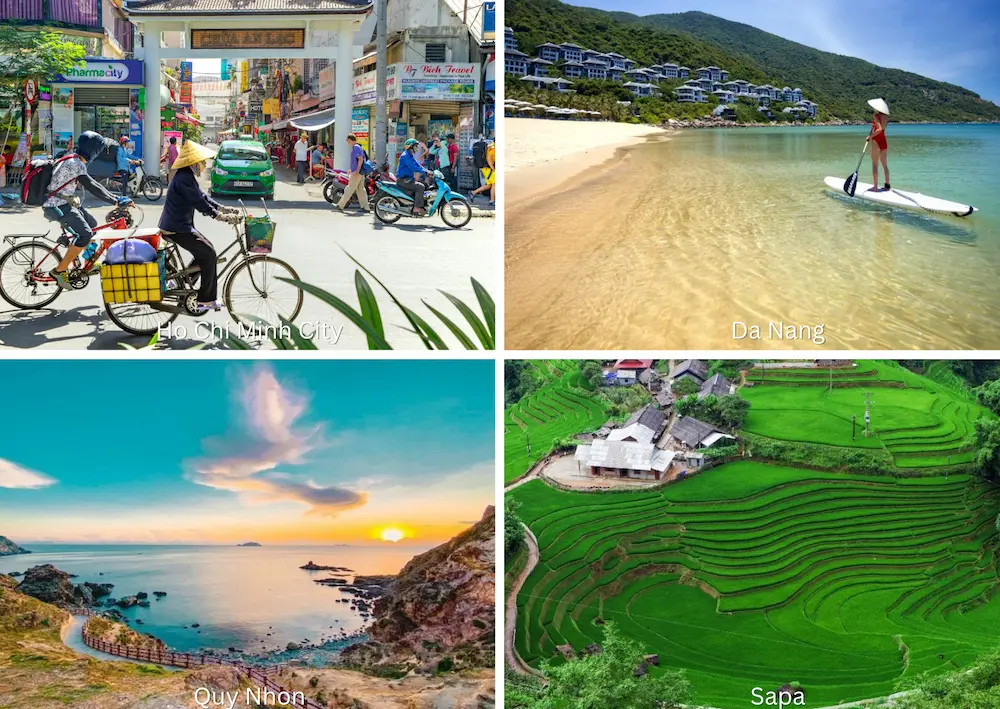
Best Things to Do in Vietnam in July and August
The heat, which should start to ease from August onwards, is common to all three regions of the country. But we can still visit the must-see sites like Hanoi, Da Nang, Ho Chi Minh City, Sapa,... It's worth noting that in July and August, quite a few groups of Vietnamese tourists can still be seen around the must-see sites.
It is best to trek in the less-touristic region to enjoy nature. You will find the rice terraces are dressed in a peaceful green across the Northeast and Northwest mountains. Towards the end of August, a green-yellow mixture can be seen in some less elevated areas in Sapa. The weather is quite dry in August, too, and trekking in the mountainous north, in the valleys, or on the mountainsides will be superb.
For beach holidays, the central beaches of Da Nang, Hoi An, Hue, Quy Nhon, and Nha Trang are generally a better choice than the southern beaches, which remain in the rainy season.
Practical Advice for Summer Vacation
Vietnam remains in high season for summer vacations with groups or families. It's best to avoid the often crowded beaches of Cat Ba Island and Da Nang, especially at weekends, where service prices are also rising. If you travel to these destinations during this period, you book well in advance.
When the storm arrives in Halong Bay, the cruises will be suspended for 1-2 days. In the event that you're already in Vietnam, you can expect your program to be adapted if you travel with a local travel agent. They can arrange an alternative to Halong Bay for you, such as Hanoi, Ninh Binh, or Mai Chau...
While there are still trekking opportunities in many mountainous areas, we want to highlight the potential for landslides in Ha Giang after a typhoon during this time. It would be better to plan a mountain itinerary in North Vietnam for this period that is less than two weeks long.
>> See the list of Vietnam hiking & trekking tours with real-time price
2.5. Travel to Vietnam in September
September is a wonderful time to visit Vietnam. If you can arrange to go during this time, don't miss it. It's autumn in North Vietnam and the central region as well, although the autumn is very short. The weather is exceptionally mild and pleasant. Additionally, domestic tourism is no longer at its peak, making it easier to find available services and high-quality tour guides.
Vietnam Weather in September
In September, the weather transitions between seasons, offering pleasant conditions throughout the country.
In the North, you can expect mild temperatures ranging from 24-31°C and decreasing rainfall, making it perfect for exploring Hanoi, Ha Long Bay, and Sapa. Central Vietnam remains warm and humid, averaging around 28°C, with minimal rainfall, ideal for enjoying the beaches of Hoi An and Da Nang. While the South is entering the final months of its rainy season, showers are shorter and less frequent, and temperatures remain warm and humid, between 24-32°C.
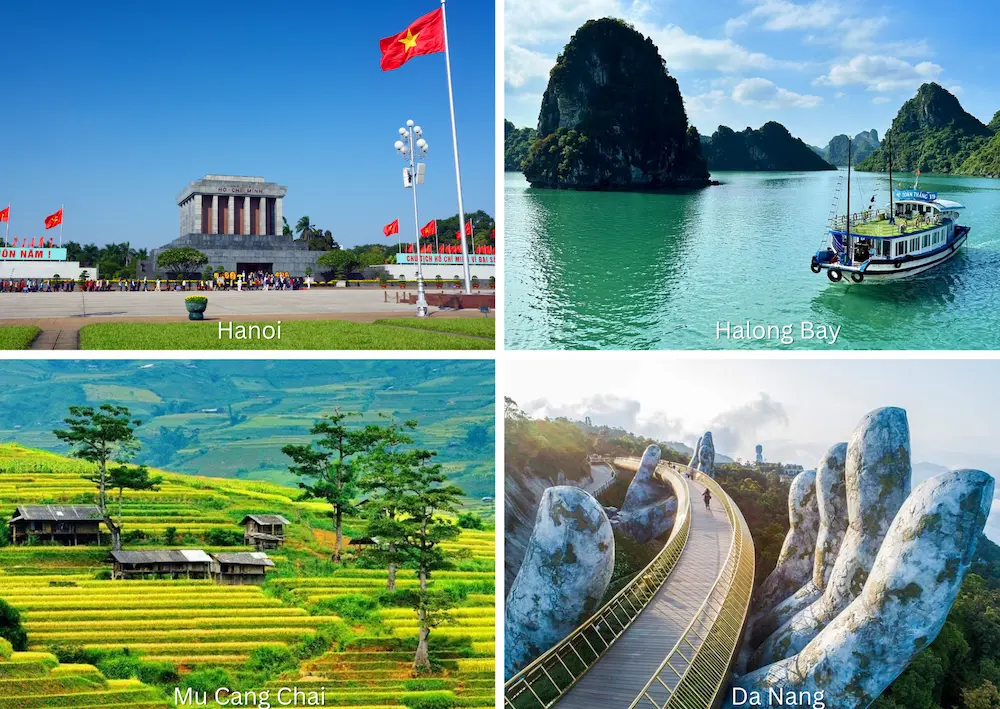
Best Things to Do in Vietnam in September
September is one of the best periods for the most comprehensive tours in all regions of Vietnam. Nature is at its most beautiful, and the weather is temperate.
For those with a passion for trekking and photography, September presents a golden opportunity to discover the enchanting rice terraces of northwest Vietnam, including Mu Cang Chai and Sapa, where the landscapes are awash in a mesmerizing yellow hue. The northeastern region also reveals its charm, with verdant scenery during this time.
Central Vietnam beaches like Hue, Da Nang, Hoi An, Quy Nhon maintain a slightly warmer embrace and allure. The sun remains plentiful without being overly scorching.
In Halong Bay, September provides ample days of clear skies, showcasing the bay's iconic limestone karsts in their full glory.
These are always the best September activities if you want us to include them in your Vietnam travel program.
Festival and Public Holidays in September
September 2nd is National Holiday, and Vietnamese people will have at least two days off. The Vietnamese once again set off en masse to the tourist attractions all over the country. If you choose to visit Vietnam around this day, you should make your reservations well in advance or plan your visits or stays outside the sites frequented by the Vietnamese on this occasion.
In September, or sometimes October, Vietnam celebrates the Mid-Autumn Festival. This festival is particularly popular among Vietnamese families, attracting many visitors to major tourist destinations like Hanoi and Hoi An. The occasion offers a great opportunity to experience Vietnamese culture through colorful lantern shows, folk dances, folk games, and delicious mooncakes.
Important notes for September vacation in Vietnam
This is probably the low season for domestic tourism in Vietnam, and the same is true for international tourism. You can enjoy many promotions if you choose to come to Vietnam during this period.
One piece of advice I can give you, among others, is that you'd better take your camera with you, as the scenery is the most beautiful anywhere in Vietnam.
>> See the list of Vietnam romantic getaway packages with real-time price
2.6. Travel to Vietnam in October and November
Vietnam Weather in October-November
North Vietnam remains roughly in autumn. Even if winter occasionally comes in from afar with rare waves of cold air currents that don't disrupt the weather too much. Central Vietnam enters its rainy season. If you sometimes see images of flooding in Hue or Hoi Ai, it's exactly at this time of year. It is essential for travelers to follow the weather forecast. South Vietnam, on the other hand, enters its dry season. October-November is actually one of the two favorite periods for tourists from Europe.
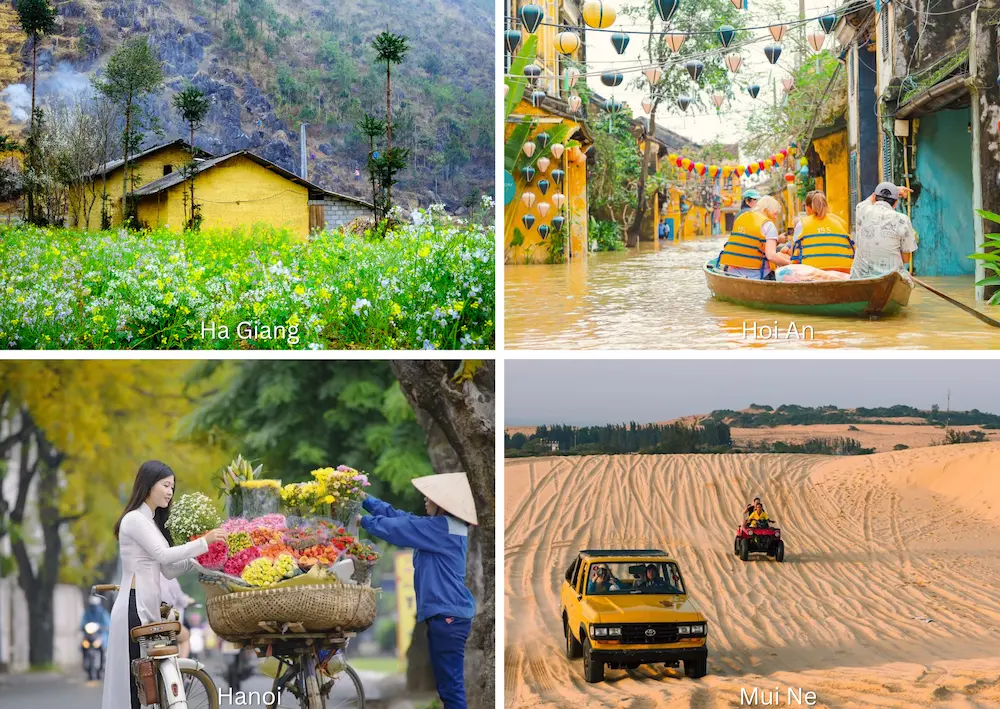
Best Things to Do in Vietnam in October-November
You can totally visit the popular tourist spots in North and South Vietnam, but it's best to be cautious when it comes to the Central due to the likelihood of rainy days.
If you're up for hiking, I would recommend the mountainous north of Vietnam, like Mai Chau, Pu Luong, Ha Giang, or even the plateaus of the south, where the rainy season is over. On the other hand, it would be more difficult to find the yellow rice terraces, as the harvest has come to an end, and all that's left in the villages is to dry or husk the rice.
For beach holidays, the beaches and islands of Central Vietnam are least recommended, in stead, southern Vietnam beaches, such as Phu Quoc, Con Dao, and Mui Ne are ideal destinations for relaxing. The calm sea waters and beautiful scenery provide an ideal escape from the city's hustle and bustle.
In addition, nature is in one of the most ideal periods of the year in Halong Bay.
Practical Advice for Travelers in October-November
As it's the peak season for foreign tourists, there's a lot of Asian tourists heading to Vietnam from places like Hong Kong, Singapore, and Malaysia. If you're planning to visit Vietnam during this time, it's best to book your accommodations, guided tour and tickets early. Considering the weather, it's a good idea to favor staying in the North and South and limit your time in the Central region. Prepare for potential changes to your plans in case of a typhoon in the Central region.
>> See the list of Vietnam family holidays with real-time price
2.7. Travel to Vietnam in December
December marks an ideal month to discover the different aspects of Vietnam, benefiting from optimal weather conditions across the country.
Vietnam Weather in December
In northern Vietnam, it is the middle of winter, with cold spells lasting several days at a time. The temperature ranges from 15 to 20°C. Record low temperatures are often observed in the high mountains, where it can sometimes drop to minus 1 or 2 degrees. Central Vietnam is transitioning out of its rainy season and the weather is mild. The southern part of the country remains in the dry season.
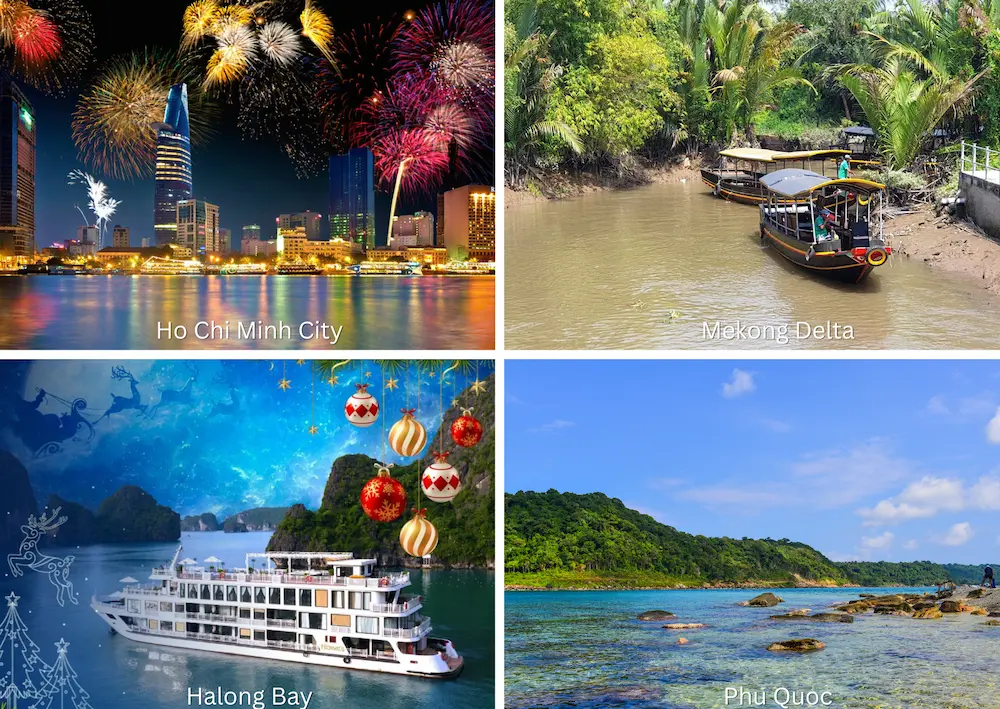
Best Things to Do in Vietnam in December
Based on the weather in December, we advise you to travel to the Central and Southern regions. While we won't completely rule out the North, we highly recommend exploring sites in the plains or middle regions of the Northeast for village strolls and homestays. Mai Chau and Pu Luong are suitable destinations for authentic discoveries.
While the North is hit by the monsoon, a Halong Bay cruise is a good bet for sunny days. The weather is cold, but there is no rain.
At this time of year, the South is the best choice for beach getaways, with options like Con Dao and Mui Ne, as well as the sunny Phu Quoc Island.
Practical Advice for Travelers in December
Given the wide range of holiday possibilities throughout the country, in the second half of December, Vietnam is becoming an increasingly popular destination for Christmas vacations for foreigners from Europe, as well as for Asian expatriates. The 3-4 star hotels around the beautiful southern beaches, or even in Sapa or Ha Long in the north, are often well booked on this occasion. Besides, most of the 4-5-star hotels charge for their Christmas and New Year's Eve Gala dinners. So it's best to make your reservations well in advance to ensure the best quality and better price for your trip to Vietnam in December.
Even if you don't plan to visit the northern mountains in December, it's a good idea to bring some warm clothes with you in case it gets cold.
Vietnam's diverse climate, influenced by its geography, makes it ideal for various travel preferences. Northern, Central, and Southern Vietnam each have distinct characteristics throughout the year. At any given time, there are always plenty of alternatives for a country with such a wide variety of things and possibilities to offer as Vietnam.
IZITOUR is a local travel agency that has provided tours and travel services for more than 3,000 travelers worldwide. We can provide you with the most well-arranged travel plan within your budget and turn it into an unforgettable trip.
Therefore, don't hesitate to contact us via our e-mail [email protected] to get personal advice on the best time to visit Vietnam. Or please complete the customized Vietnam tour form with your personal preferences. Let IZITOUR take care of the rest. Our travel consultant will contact you to provide the best suitable travel program and any seasonal offers.
10 best-selling Vietnam tours with real-time price
See more:
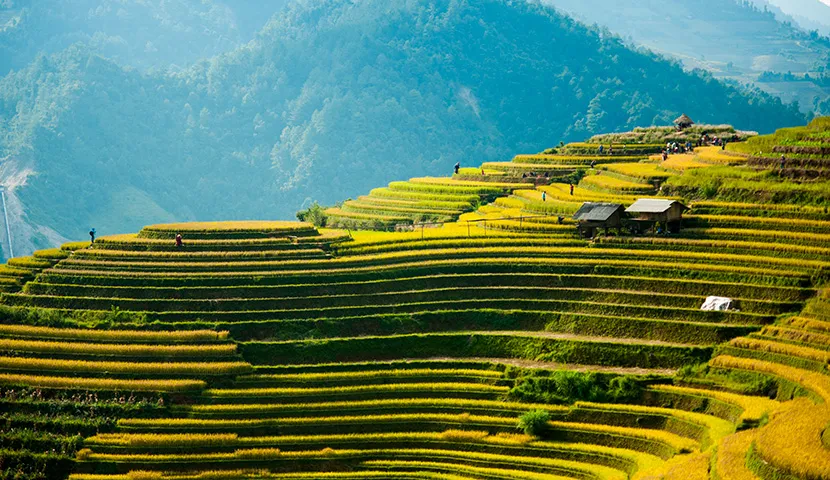







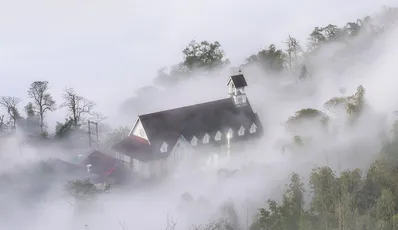

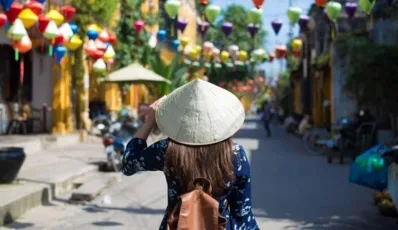

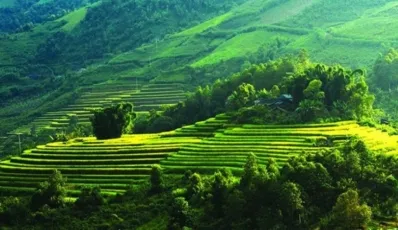
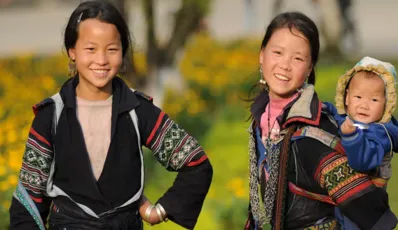

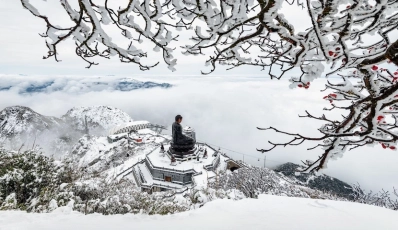
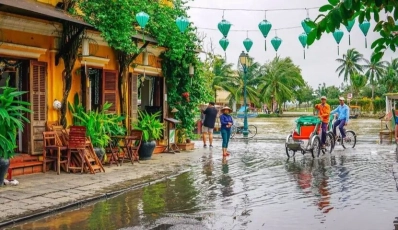




 TRAVELERS' CHOICE 2025
TRAVELERS' CHOICE 2025 



28 Comments
Russian Federation
We traveled to Vietnam during the rainy season, but luckily, it always rained at night. When we woke up, everything felt fresh and rejuvenated. I hope to visit beautiful Vietnam again soon.
United States
We're planning a trip to Vietnam this August and would love your help putting together the best itinerary for us. We're a group of four adults in our 50s from the U.S. and Italy. We're all in good health and active, but we prefer to travel at a relaxed pace and would like to avoid any strenuous trekking. Thanks in advance!
Vietnam
Italy
Vietnam
United States
Vietnam
India
Vietnam
France
Vietnam
Italy
I love this article, it helped me a lot to prepare my trip to Vietnam. However, I also want to discover about Vietnam culture and local life. So what are the best festivals in Vietnam, and do they align with specific weather conditions?
Vietnam
United States
Vietnam
Portugal
Vietnam
France
Vietnam
Jamaica
Vietnam
Australia
Vietnam
Ireland
Vietnam
Italy
What you can offer to visit the north in 10 days max in September. We have ideas about Hanoi, Cat Ba, Sapa, Bac Ha, Ha Giang… but we are always open to your suggestions.
Burundi
Vietnam
Thank you for your comment, Lidia. Have great journey!
Write Reply